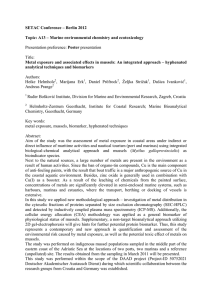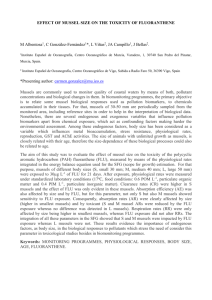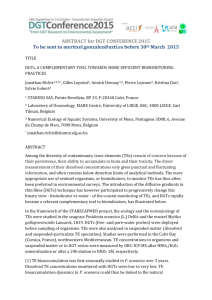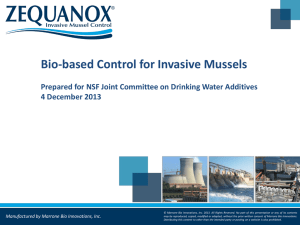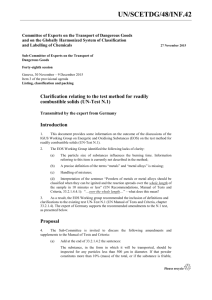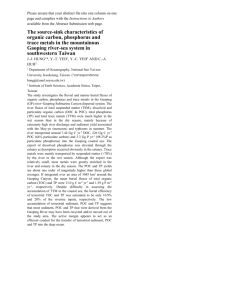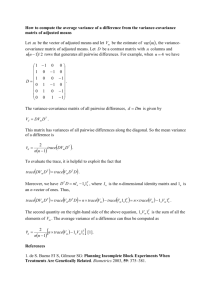Richir et al._DGT-conference-2015_abstract book
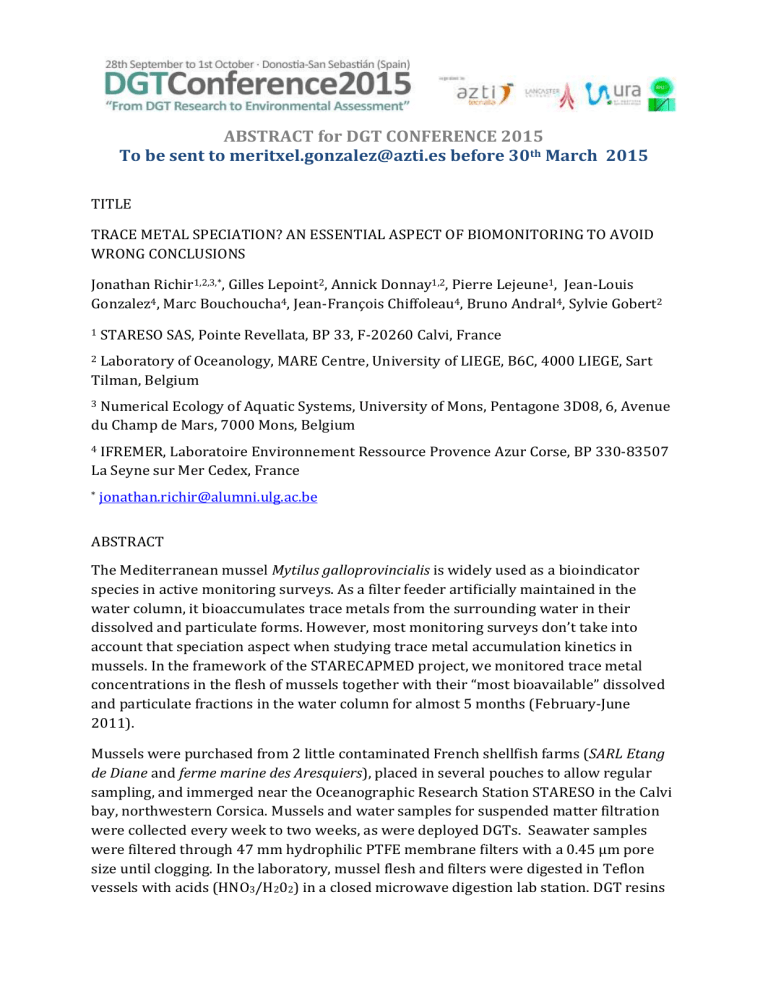
ABSTRACT for DGT CONFERENCE 2015
To be sent to meritxel.gonzalez@azti.es before 30
th
March 2015
TITLE
TRACE METAL SPECIATION? AN ESSENTIAL ASPECT OF BIOMONITORING TO AVOID
WRONG CONCLUSIONS
Jonathan Richir 1,2,3,* , Gilles Lepoint 2 , Annick Donnay 1,2 , Pierre Lejeune 1 , Jean-Louis
Gonzalez 4 , Marc Bouchoucha 4 , Jean-François Chiffoleau 4 , Bruno Andral 4 , Sylvie Gobert 2
1 STARESO SAS, Pointe Revellata, BP 33, F-20260 Calvi, France
2 Laboratory of Oceanology, MARE Centre, University of LIEGE, B6C, 4000 LIEGE, Sart
Tilman, Belgium
3 Numerical Ecology of Aquatic Systems, University of Mons, Pentagone 3D08, 6, Avenue du Champ de Mars, 7000 Mons, Belgium
4 IFREMER, Laboratoire Environnement Ressource Provence Azur Corse, BP 330-83507
La Seyne sur Mer Cedex, France
* jonathan.richir@alumni.ulg.ac.be
ABSTRACT
The Mediterranean mussel Mytilus galloprovincialis is widely used as a bioindicator species in active monitoring surveys. As a filter feeder artificially maintained in the water column, it bioaccumulates trace metals from the surrounding water in their dissolved and particulate forms. However, most monitoring surveys don’t take into account that speciation aspect when studying trace metal accumulation kinetics in mussels. In the framework of the STARECAPMED project, we monitored trace metal concentrations in the flesh of mussels together with their “most bioavailable” dissolved and particulate fractions in the water column for almost 5 months (February-June
2011).
Mussels were purchased from 2 little contaminated French shellfish farms (SARL Etang
de Diane and ferme marine des Aresquiers), placed in several pouches to allow regular sampling, and immerged near the Oceanographic Research Station STARESO in the Calvi bay, northwestern Corsica. Mussels and water samples for suspended matter filtration were collected every week to two weeks, as were deployed DGTs. Seawater samples were filtered through 47 mm hydrophilic PTFE membrane filters with a 0.45 µm pore size until clogging. In the laboratory, mussel flesh and filters were digested in Teflon vessels with acids (HNO
3
/H
2
0
2
) in a closed microwave digestion lab station. DGT resins
ABSTRACT for DGT CONFERENCE 2015
To be sent to meritxel.gonzalez@azti.es before 30
th
March 2015
were eluted for 24h in 1.0 M HNO
3
. Trace metal concentrations (Cr, Mn, Co, Ni, Cu, Zn,
Ag, Cd, Pb) were measured by DRC-ICP-MS. Analytical accuracy was checked by analyzing CRMs.
All the studied metals except Pb and Zn were present in the water column to over 80% in their dissolved form. The contribution of the dissolved pathway was thus likely to be predominant in the oligotrophic Calvi bay . Dissolved trace metals showed little temporal variability of their levels, likely resulting from the integration over time of their levels in the DGT probes and the lack of seasonality of this fraction. In contrast, Zn showed great variability of its particulate fraction during the survey. Such temporal variability was also observed for Cr, more abundant in its particulate form at the end of the survey, and for Mn and Pb that conversely tended to decrease. The dynamic of trace metals in the mussel flesh is regulated by the environmental bioavailability of dissolved and particulate metals, the ecophysiological status of mussels and the trophic conditions of the water body. In the oligotrophic Calvi bay, showing background contamination levels by metals, the trophic conditions played a major role once out of the spring plankton bloom. It led to the increase of metal concentrations measured in the flesh of mussels undergoing starvation. However, some metals such as Cu and Co displayed only little temporal variations of their concentrations, these essential micronutrients being well regulated.
The combined study of trace metal bioavailability and mussel ecophysiology in defined environmental conditions allows discriminating against biotic and abiotic factors regulating contaminant uptake in mussels, thus avoiding wrong conclusions about the observed dynamics of the studied contaminants. Mussels are a good proxy of coastal water quality, but their proper use notably requires adjustment of raw contaminant concentrations with trophic status of monitored sites.
KEY WORDS
Trace metal, speciation, biomonitoring, Mytilus galloprovincialis, Calvi bay
TO BE PRESENTED IN SESSION 5: Environmental Assessment and Legislation
POSTER COMMUNICATION
